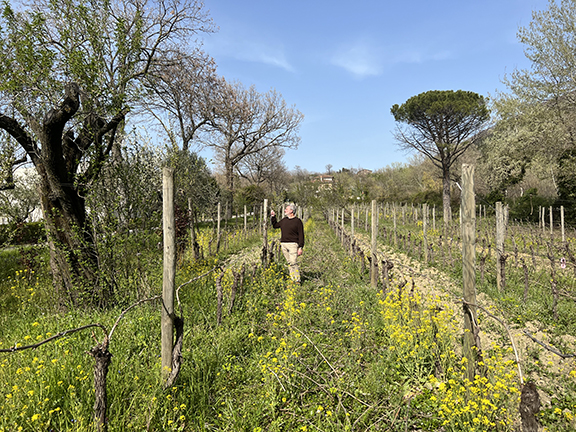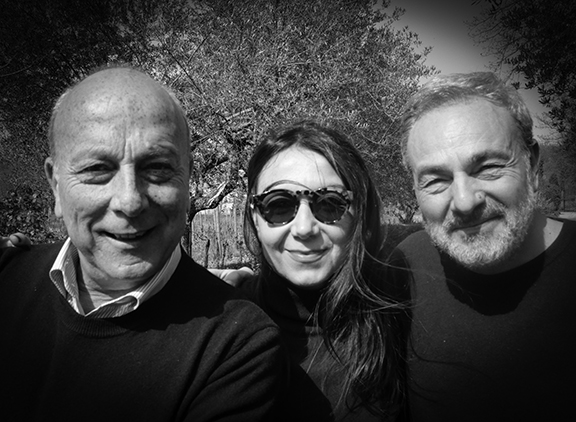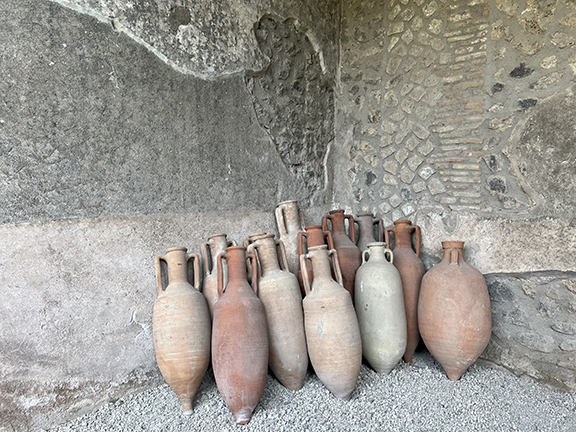Campania offers some of Italy's great sensory experiences from the beaches of the Amalfi Coast, the ruins of Pompeii, to the food and energy of Naples. It also is home to four of Italy's great wine grapes Aglianico, Fiano di Avellino, Falanghina and Greco di Tufo.
 The Di Meo winery, located in the province of Avellino, is one of the most celebrated Campania estates focusing squarely on native varietals. In the early '80s, three siblings Erminia, Generoso and Roberto Di Meo acquired the historical estate from their parents, which includes 25 hectares and an 18th century farmhouse that was once a hunting lodge of the Caracciolo Prince. In addition to wine the Di Meo brothers are supporters of the arts and have created a unique annual calendar which celebrates a different city each year in collaboration with important international photographers.
The Di Meo winery, located in the province of Avellino, is one of the most celebrated Campania estates focusing squarely on native varietals. In the early '80s, three siblings Erminia, Generoso and Roberto Di Meo acquired the historical estate from their parents, which includes 25 hectares and an 18th century farmhouse that was once a hunting lodge of the Caracciolo Prince. In addition to wine the Di Meo brothers are supporters of the arts and have created a unique annual calendar which celebrates a different city each year in collaboration with important international photographers.
Grape Collective talks to Roberto Di Meo (photo right) about the unique terroir and grapes of Campania.
Talk a little bit about the history of the Di Meo Winery.
Roberto Di Meo: The Di Meo farm is a historical farm in the area taken over by myself and my brother in the early 1980s. We founded the company in 1986. We are in an historic 18th century location in Salza Irpina, in the Avellino province. We have about 350 hectares of property spread over the various territories, of which a portion are cultivated with specialized vineyards. Fiano di Avellino, Greco di Tufo and Aglianico for the Taurasi.
 Over time, they have gradually expanded both the transformation and the vinification of typical grapes of the Irpinia area. So in addition to the three DOCGs, we also worked on the search for historical grapes and vines of the area, to take them later to the tables of consumers and connoisseurs and collectors from all over the world. So Fiano, Greco di Tufo, Aglianico.
Over time, they have gradually expanded both the transformation and the vinification of typical grapes of the Irpinia area. So in addition to the three DOCGs, we also worked on the search for historical grapes and vines of the area, to take them later to the tables of consumers and connoisseurs and collectors from all over the world. So Fiano, Greco di Tufo, Aglianico.
Please describe the terroir in Campania.
The terroir in the Irpinian territory is extremely heterogeneous. It is always difficult to explain what the soils of the Irpinia territories are like. There is so much difference at such a short distance, great diversity exists.
The soils are very heavy, they are generally clay, with different textures. In the Greco di Tufo areas, for example, the soils are very mineral. In the center, in the heart of cultivation of Greco di Tufo, therefore right in the village of Di Tufo, there were active sulfur mines until the 1980s. As a result, this note is very present, a very strong sulfurous note. Additionally, a large part of Irpinia was affected by the explosion of Vesuvius or the latest eruptions and so there is a volcanic influence across all territories, apart from having great differences.
Going towards Mirabella Eclano, Grottaminarda, towards the Puglia side, we have very loose soils. Going to the higher slope of Montemarano Paternò, we have extremely compact, full-bodied, clayey soils, with silt of different textures.
 Roberto, what is your philosophy of viticulture and philosophy of winemaking?
Roberto, what is your philosophy of viticulture and philosophy of winemaking?
The philosophy in the countryside and in the cellar is very, very simple. I have always observed what our ancestors did. In our historic vineyards there is still a pre-phylloxera vineyard of which I make an ungrafted wine, therefore ungrafted plants, because it is important to understand the history in order to be able to move forward.
(Generoso Di Meo, Paola Vitale, Roberto Di Meo)
The job is a very simple job. I don't use chemicals, I don't use any type of herbicide. I use traditional tillage in an absolutely natural way, as far as my philosophy is concerned. Both as natural fertilizers we use green manure, therefore broad beans and field beans to add nitrogen to the soil.
The tillage is absolutely done with post-harvest markings of the grapes. A row yes, a row no, in order to be able to stimulate the roots to go deep. We have a territory rich in water in the subsoil and therefore we avoid using to date any type of irrigation, even in emergency.
In the cellar, then, we work with absolute serenity in maintaining everything we have managed to achieve in the countryside, everything I did in the countryside, therefore with absolutely healthy grapes at the right point of ripeness. Acidity, alcohol content. I work a lot on the tasting of the grapes to decide the right harvest date of the ripening grapes, following my perception in tasting the grapes.
In the cellar we work a lot in reduction with the use of cold, with the use of dry ice in such a way as to allow the entire vinification phase to be practiced in the absence of air. I have specialized over the years in longevity, and to experience the longevity of the Irpinia vines such as Fiano di Avellino, the Greco di Tufo, and today, I put wines on the market even after twenty years. They spend 15 or 18 years aging to refine over time, so this is a process following what was the tradition of the past with today's knowledge and technology.
Talk a little bit about the history of wine in Campania.
 It is an ancient history. We now have evidence of viticulture in Campania from very old times, all Pompeian finds. I too have created a wine with the National Archaeological Museum of Naples, recalling an old wine amphora found in Pompeii. That said, we have tons of wines from history linked to the Campania region.
It is an ancient history. We now have evidence of viticulture in Campania from very old times, all Pompeian finds. I too have created a wine with the National Archaeological Museum of Naples, recalling an old wine amphora found in Pompeii. That said, we have tons of wines from history linked to the Campania region.
Pre-phylloxera Campania, especially Irpinia, produced a lot. It was the second province in Italy for production. Today we produce a very limited number of quintals of grapes throughout the territory, if we consider the Campania region produces just over 750,000 hectoliters of total wine, dislocating between the various provinces.
The territories are absolutely with a viticultural vocation and we only have native vines. Very little has been internationalized in Campania, there is very little Chardonnay or other international grape varieties and there are over 150 local indigenous varieties. The first DOCG of central-southern Italy, the Aglianico for the production of Taurasi. DOCG was in 1993.
Then there were two more accolades in 2003; the Fiano di Avellino and the Greco di Tufo to finish with the Aglianico del Taburno Benevento. But aside from these accolades, we have so many grapes of ancient origins. Minor, because they are produced in very limited quantities. If we think of the Amalfi Coast, if we think of Vesuvius, Vesuvius with its red and white grapes. Il Tintore, an almost unknown grape of the Amalfi Coast. In every single area of the Campania region we have something very, very special.














